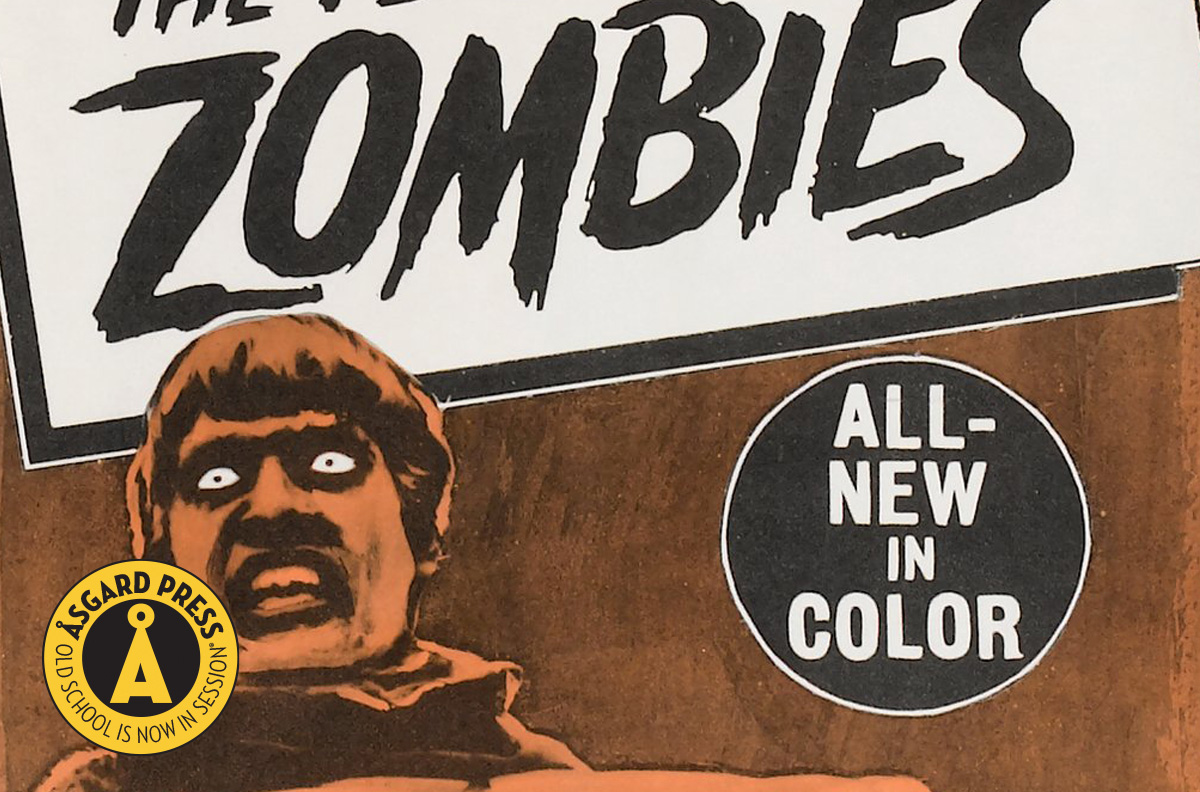5 Must-See Zombie Movies
Log in to any streaming service these days, and you’ll see a plethora of TV shows and movies devoted to the zombie genre. As living humans, we are fascinated with the idea of the living dead. Whether it’s awkwardly shuffling corpses or dead-eyed beings in service to a controlling master, zombie movies have transformed the horror genre since the first true undead film, White Zombie, premiered in 1932.
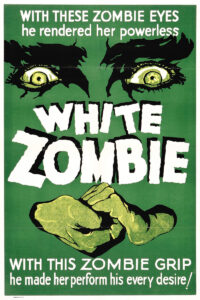
If you are searching for something to binge-watch this fall, here are five zombie movies that are a must-see for undead and horror fans. Commentary for each film is courtesy of Dr. Arnold T. Blumberg, co-author of Zombiemania: 80 Movies to Die for (Telos, 2007).
THE PLAGUE OF THE ZOMBIES
20th Century Fox, 1966
Director: John Gilling
Cast: André Morell, Diane Clare, Brook Williams, Jacqueline Pearce, John Carson
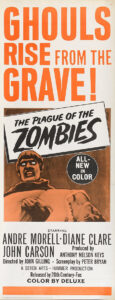
Released just two years before George Romero would forever alter the living dead genre, The Plague of the Zombies is often seen as the last gasp of the classic zombie film template established by White Zombie in 1932; much of this movie is a simple transposition of familiar Voodoo zombie elements from Haiti to Cornwall. When Sir James Forbes (Morell) is asked to investigate a mysterious plague in a small village, the trail leads to the elegant but sinister Squire Clive Hamilton (Carson), whose dabbling in the dark arts has created a slave army of reanimated corpses to work the nearby mine. Shot just before Hammer’s The Reptile and using many of the same sets and some of the same crew, Plague is not as celebrated as Hammer’s Dracula or Frankenstein series but makes good use of the studio’s flair for gothic atmosphere and excellent casting. The zombies are truly frightening in appearance; Roy Ashton’s celebrated makeup design was achieved with tissue paper, Fuller’s earth, liquid latex, and white contact lenses with pinprick holes for the actor to see through. The movie’s ending evokes the Universal monster era of the 1930s and ’40s, as a mansion burns down with lovers watching pensively from a hilltop.
“I realized long ago that in order to be popular, one must conform. I find that too big a price to pay.”
NIGHT OF THE LIVING DEAD
Image Ten, 1968
Director: George A. Romero
Cast: Duane Jones, Judith O’Dea, Marilyn Eastman, Karl Hardman, Judith Ridley, Keith Wayne, Kyra Schon, Bill Hinzman
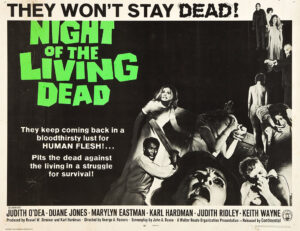
Entire books have been written about this landmark horror film, and over fifty years later, its impact has not diminished. The harrowing tale of an unlikely group of survivors trapped in a Pennsylvania farmhouse as the unburied dead gather outside, hungry for living human flesh, Night tackles everything from race and gender politics to the disintegration of the post-war American nuclear family and the Vietnam-era desensitization to violence. Although the production was accomplished with a low budget and chocolate syrup subbing for blood, there is no denying the power behind some of its most memorable macabre sequences, including a climactic confrontation between a mother and her own undead daughter. While much of the movie’s legacy is associated with its shocking subject matter and barrier-shattering visuals, like a scene in which the reanimated dead feast on two of the survivors, the real dramatic center-point of the film is what fans refer to as the “Beekman’s Diner speech.” In the midst of creepy carnage from carnivorous corpses and constant arguing amongst the survivors, Ben (Jones) takes center stage for several quiet minutes as he tells the story of his experience at the diner just prior to arriving at the farmhouse. It’s an unforgettable, nuanced, and painfully real performance.
“You can be the boss down there, but I’m boss up here!”
DAWN OF THE DEAD
United Film Distribution Company, 1978
Director: George A. Romero
Cast: David Emge, Ken Foree, Scott Reiniger, Gaylen Ross
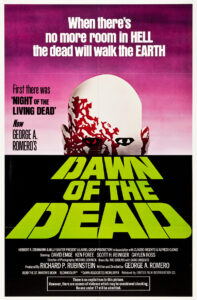
Although Romero’s Night of the Living Dead virtually invented the concept of the modern zombie, it is with Dawn that so many of the genre’s most familiar tropes and storytelling ‘rules’ were introduced and set down for generations of horror film makers to come. As our usual unlikely group of survivors – two TV station employees and a couple of SWAT police officers – make their way to safety in the midst of a zombie apocalypse, they decide to set up temporary house at the then-new phenomenon of the day, an indoor shopping mall. Perfectly reflecting the tailor-made metaphor of rampant consumerism in both the setting and the ravenous undead stalking its halls, Dawn of the Dead is a template for social and cultural commentary through the use of zombies. Featuring a stunningly bleak and yet occasionally peppy score by Goblin and overcoming the unfortunate makeup miscalculation that left the living dead in this film with an overtly blue-tinged pallor, the movie exists in multiple cuts released in the US, internationally, and via home video. In any form, Dawn is a powerful indictment of the worst aspects of human nature – especially toxic masculinity – that manages to presage its successors, such as The Walking Dead, while also serving as a terrifying time capsule of late ’70s America.
“When the dead walk, señores, we must stop the killing… or lose the war!”
ZOMBIE
The Jerry Gross Organization, 1979
Director: Lucio Fulci
Cast: Tisa Farrow, Ian McCulloch, Richard Johnson, Al Cliver, Auretta Gay, Olga Karlatos
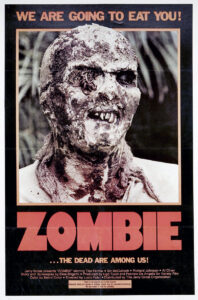
Capitalizing on the success of Dawn of the Dead when it was released in Italy under the title Zombi, this unofficial sequel – called Zombi 2, Zombie in the US, and Zombie Flesh Eaters in the UK – takes the daughter of a research scientist (Farrow) and an investigative reporter (McCulloch) to the island of Matool, where they meet another couple (Cliver, Gay) and discover Dr. Menard (Johnson) dealing with a plague of the living dead. An iconic film whose poster image symbolized the genre for generations with its unforgettable close-up of a skull-like, decaying corpse with worms in one eye (eventually appearing on countless black t-shirts in horror fandom for decades), Zombie also included some infamous sequences, such as a battle between a zombie and a shark at the bottom of the ocean depths (performed by a real shark and a shark trainer in makeup), and a concluding scene shot illegally on top of the Brooklyn Bridge. Fabio Frizzi’s score – in particular his propulsive, pounding theme – remains a genre highlight, and fans still regularly intone Johnson’s cold delivery of the movie’s most quotable line (which is heard twice at different points in the film). In the early 1980s, Zombie was one of the original 39 “video nasties” successfully prosecuted in the UK by their DPP (Director of Public Prosecutions) for obscenity.
“The boat can leave now. Tell the crew.”
TOXIC ZOMBIES
CM Productions, 1980
Director: Charles McCrann
Cast: Charles Austin (McCrann), Beverly Shapiro, Dennis Helfend, John Amplas
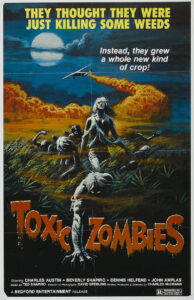
Also known as Forest of Fear, Bloodeaters, and The Dromax Derangement, Toxic Zombies is a truly low-budget (more like no-budget) effort in which a group of marijuana farmers that just want to grow their crops in peace and be super mellow about it all are targeted by a government-approved herbicide called Dromax as part of an anti-drug initiative. When the substance washes over their crop of cannabis, and winds up turning the farmers into vicious cannibal monsters as well, a wave of bloody flesh-eating is bound to erupt. Frequent George Romero regular John Amplas (Dawn of the Dead, Day of the Dead, Martin, Creepshow) makes an appearance as a federal agent to lend the proceedings just a bit of genre credibility. The movie is credited by some as being the first in the subgenre of “redneck zombie” films, which are surprisingly numerous, especially throughout the 1980s. Early in that decade, Toxic Zombies was also one of the original 39 “video nasties” successfully prosecuted in the UK by their DPP (Director of Public Prosecutions) for obscenity. And perhaps the most sobering detail is that helmer Charles McCrann went on to become the Senior Vice-President of Marsh & McLennan, a financial services company that had offices in the World Trade Center in New York City; McCrann died there on September 11, 2001.
“Man is the most dangerous predator in these parts.”
Zombie movies often explore very real issues facing living humans. Perhaps that explains why the living are so interested in the undead. Whatever your reasons for watching zombie movies, you’re sure to enjoy at least one of these five. And if you would like to see more monster movie posters, and read more commentary by Dr. Arnold T. Blumberg, check out our 2024 Vintage Monsters Calendar, a collection of 13 frame-ready prints of monster movie posters complete with all the details.

